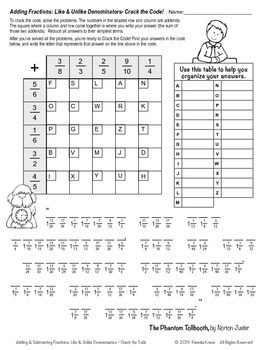Add & Subtract Fractions - Like & Unlike Denominators - Crack the Code
- PDF
What educators are saying
Also included in
- Fractions & Decimals Computation Practice ~ Phantom Tollbooth Crack the Codes BUNDLED! offers fun and engaging ways for students (grades 5-7) to get computation practice. With 8 different puzzles, they’ll enjoy a variety of problem-solving challenges. Feedback is immediate through solving the puPrice $9.25Original Price $13.25Save $4.00
- Math Practice Activities Crack the Code Super Bundle for grades 5-7 includes over 40 Crack the Code self-checking puzzles practicing a variety of math skills. Many of the selections are differentiated so that all ability levels are challenged. These engaging activities are loaded with mental mathPrice $52.25Original Price $67.25Save $15.00
Description
This engaging math activity is a fun way for students to get computation practice adding and subtracting mixed numbers and common fractions. They’ll enjoy the challenge and feedback is immediate through solving the puzzles (quotes from The Phantom Tollbooth) correctly.
This activity includes two different puzzles. One is addition of common fractions and the other, subtraction with mixed numbers.
Problems are set up in a table format which can be visually distracting for some students, so one of the sheets in each puzzle has a mini-alphabet table to help organize their work. The other view does not include those mini-tables, allowing students to organize their thinking in a way that works for them.
Included in this resource:
♦ A sample showing how to solve these types of problems is included for a class mini-lesson, in color/BW
♦ 25 problems (addition) 20 problems (subtraction)
♦ Adding common fractions with like or unlike denominators
♦ Subtraction with regrouping (borrowing)
♦ Finding common denominators
♦ Reducing improper fractions
♦ Reducing fractions to lowest terms
♦ Using a table to record answers
♦ All student pages are in black & white.
Ways to use Crack the Code puzzles~
- Centers
- Go-to Activities
- Fun Class Challenge
- Small Group Challenges
- Paired Work (Buddy up!)
- Test Prep
- Homework
- Sub Days
- RTI
Quotes:
“Results are not guaranteed, but if not perfectly satisfied, your wasted time will be refunded.”
"So many things are possible, just as long as you don't know they're impossible."
~Norton Juster, The Phantom Tollbooth
Be sure to check out Finding Least Common Multiples & Greatest Common Factors - Crack the Codes for additional practice with GCFs and LCMs.
Click HERE for additional Crack the Code puzzles.
***************************************************************************
Customer Tips:
How to get TpT credit to use on future purchases:
Please go to your My Purchases page (you may need to login). Beside each purchase you’ll see a Provide Feedback button. Simply click it and you will be taken to a page where you can give a quick rating and leave a short comment for the product. Each time you give feedback, TpT gives you feedback credits that you use to lower the cost of your future purchases. I value your feedback greatly, as it helps me determine which products are most valuable for your classroom, so I can create more for you.
Be the first to know about my new discounts, freebies and product launches:
Look for the green star next to my store logo and click it to become a follower. Voila! You will now receive email updates about this store!
Thanks for stopping by! Pam Kranz
***************************************************************************
© Pamela Kranz Desktop Learning Adventures All Rights Reserved







